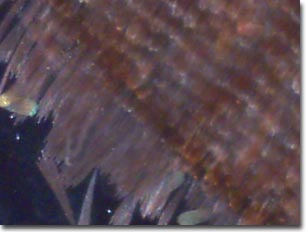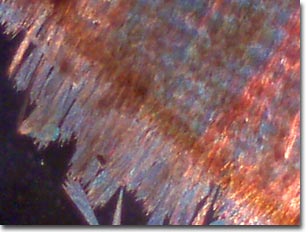Advanced Condenser Systems: Abbe Condensers
Butterfly Wing Scales
The images below compare performance of the Intel Play QX3 Computer Microscope with and without the aid of an organized cone of illumination from a darkfield Abbe substage condenser containing an aperture diaphragm. These photomicrographs are unretouched and were captured with the QX3 interactive software.
A network of scales covers most of the butterfly wing, giving it a beautiful array of colors produced either by pigmentation or through optical interference. The iridescent colors usually associated with butterfly wings arise from the small ridges on the scales, which interact with light causing constructive and destructive interference, much like that produced by a soap bubble. Other coloration in the wing is caused by clusters of dehydrated blood cells, leading to a wide spectrum of colors that we see as distinct patterns in the wings.
Butterfly Wing Scales


Semi-transparent insects are difficult to image using unaided brightfield optical microscopy. The images above were recorded using the Intel Play QX3 microscope in transmitted darkfield illumination mode. On the top is a digital image from a stock QX3 microscope using auxiliary illumination provided by a fiber optic light pipe through a hole drilled into the mixing chamber. The image on the bottom was recorded using the QX3 microscope body and a Nikon achromatic substage condenser of low numerical aperture.
BACK TO TRANSMITTED DARKFIELD GALLERY
